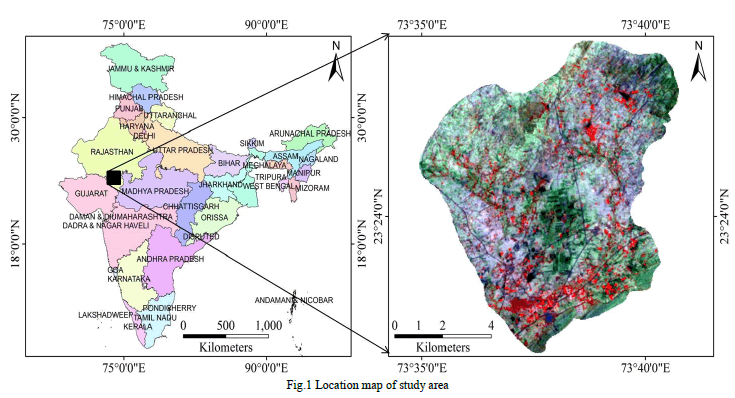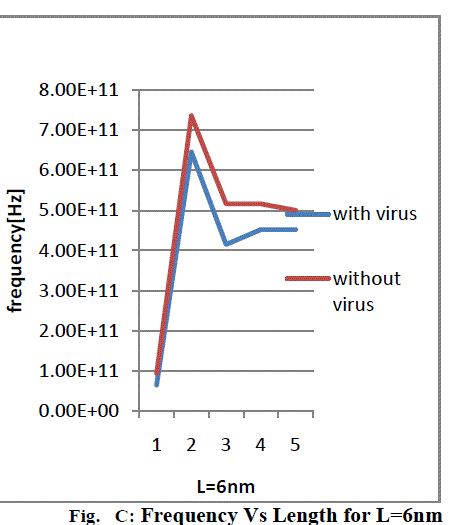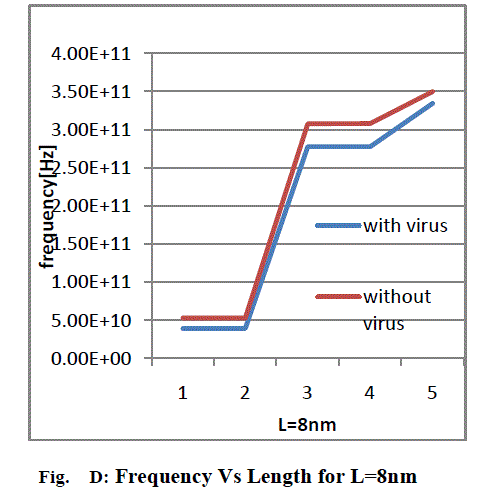ISSN ONLINE(2319-8753)PRINT(2347-6710)
ISSN ONLINE(2319-8753)PRINT(2347-6710)
| Ankit Gupta1, Sachin Kumar2, Abhinav Kashyap3 Assistant Professor, Moradabad Institute of Technology, Moradabad (U.P.) INDIA Project. Student, Moradabad Institute of Technology, Moradabad (U.P.) INDIA Project Student Moradabad Institute of Technology, Moradabad (U.P.) INDIA |
| Related article at Pubmed, Scholar Google |
Visit for more related articles at International Journal of Innovative Research in Science, Engineering and Technology
The feasibility of the Boron Nitride Nanotubes (BNNTs) as nanomechanical resonators is investigated in the present study. An FEM model of fixed -free SWBNNT is used to investigate the suitability of SWBNNT as virus sensor. Dynamic analysis of fixed free SWBNNT has been carried out with different dimension of nanotubes keeping thickness and diameter constant. In this paper we have calculated the frequency shift of SWBNNT by taking difference of resonant frequency of SWBNNT with and without the virus atom. It is investigated that more is a frequency shift more will be the mass sensitivity of nanotubes.
Keywords |
| CNT, BNNT, Cytomegalovirus, Bio-sensor etc |
INTRODUCTION |
| Since their ever thinking of people to think smaller and smaller leads to the discovery [1,2] in 1991, carbon nanotubes (CNTs) which have received much attention as a new class of nanomaterials [3,4] Carbon has a unique position among the chemical elements: it is the element participating in (by far) the largest number of compounds and it is one of the lightest elements that forms covalently bonded solids at room temperature. Therefore, we should not be surprised if carbon also plays a special role in nanotechnology. They have unique physical properties. A single tube has a diameter of approximately one nanometer, and can be up to several micrometers in length. The strong chemical bond between neighboring carbon atoms leads to very useful mechanical properties: individual carbon nanotubes have high Young’s modulus and record tensile strengths, when these mechanical properties are normalized to density. |
| By R Chaudhory et al. The principle of mass detection using resonators is based on the fact that the resonant frequency is sensitive to the resonator mass, which includes the self-mass of the resonator and the attached mass. The change of the attached mass on the resonator causes a shift to the resonant frequency. The prospect of reaching this sensitivity level has been motivating tremendous effort for years, because it corresponds to the mass of one proton (1.67 yg) [5]and thus opens the possibility to distinguish between different chemical elements in future inertial mass spectrometry measurements.[6]. In analysis of classical one-dimensional beam-like macrostructures, two theories are usually employed, namely Euler– Bernoulli and Timoshenko beam theories [7]. Both theories adopt the postulate that plane sections remain plane after deformation. Basic difference between classical elasticity and non local elasticity is definition of stress: stress at a point is function of strain at that point in local elasticity, whereas in local elasticity stress at a point is function of strains at all points in the continuum. In nonlocal elasticity, forces between atoms and internal length scale are considered in construction of constitutive equations [8-9] A wide range of applications of carbon nanotubes have been reported in the literature, one of these applications is in biology [10-15], especially in medical technology [16] and sensors [17-19] which can be broadly classified into two categories [20-21]: chemical sensors [22] and biosensors [23-25] |
II. VIRUS TO BE SENSED |
| Human cytomegalovirus is a species of the cytomegalovirus family of viruses, which in turn is a member of the viral family known as Herpesviridae or herpesviruses.[26] Although they may be found throughout the body, HCMV infections are frequently associated with the salivary glands. HCMV infection is typically unnoticed in healthy people, but can be life-threatening for the immune compromised, such as HIV-infected persons, organ transplant recipients, or new born infants. [27] After infection, HCMV has an ability to remain latent within the body over long periods. Eventually, it may cause mucoepidermoid carcinoma and possibly other malignancies.[28] The family Herpesviridae is comprised of viruses characterized by a distinct morphology. Virion particles are enveloped and have a diameter of ~200 nm. The icosahedral capsid contains a double stranded linear DNA molecule with a molecular weight of 80–150 million daltons |
| CMV is mainly a problem for certain high-risk groups, including: |
| 1-unborn babies whose mothers become infected with CMV during the pregnancy |
| 2-children or adults whose immune systems have been weakened by disease or drug treatment, such as organ transplant recipients or people infected with HIV. |
| A. Diagnosis and Treatment: |
| CMV is diagnosed by taking a sample of fluids from the infected person’s throat, urine, blood, or other body tissues or fluid. We will take up a single virus and apply it in the cantilever position on the CNT tube through the help of ansys software. Serological tests can be applied to look for certain antibodies to CMV infection. Their presence can signal an active CMV infection. Special viral DNA-detecting tests are also sometimes used to diagnosis CMV infection. |
| Currently, no specific treatment is available or recommended for otherwise healthy people with CMV infection. In those who are particularly vulnerable for complications like newborn infants, organ-transplant patients, and people being treated for cancer or who have immune disorders such as AIDS, some antiviral medications may be used intravenously. Oral antiviral medication also may be used at home once the infection is under control and the patient is stable. Some of the drugs used include CMV-immune globulin (CMV-IVIG) and the antiviral drug Ganciclovir. The protection provided was limited and a number of subjects contracted CMV infection despite the vaccination. In one case also congenital CMV was encountered [29] It also transfer in liver transplantation [30]. |
 |
| III. VIBRATION ANALYSIS OF SWBNNT BASED NANO MECHANICAL RESONATOR In this we will use continumm approach inspiring from the continuum model of Carbon Nanotubes used in beam and shell configuration [31-33].Now we will relate analytical equation to resonant frequency of the SWBNNT which is generated by the mass attached on the SWBNNT with the help of the Euler Bernoulli beam theory [34] which is expressed by the equation |
 |
| Where A is the cross sectional area E is the Young’s Modulus, I is the second moment of cross section and ρ is the density of the material. The resonant frequency of combined system can be derived by considering the length of BNNT as L and the location of attached mass. The equation of resonant frequency can b given as |
 |
| Where meq shows the attached mass and the keq shows the equivalent stiffness. In the present study fixed-free (cantilevered) boundary condition is taken in in consideration. In fixed free boundary, the mass is attached at the tip of free end. |
IV. CANTILEVERED SWBNNT WITH ATTACHED MASS AT THE TIP |
| In this we will attach the glucose particle at the tip of the SWBNNT which will be considered as mass M, which will give rise to the virtual force at the location of masses that deflection under the mass becomes unity. Equivalent stiffness deflection shape along the length can be given as |
 |
| and the mass equivalent of SWBNNT can be given as the: |
 |
V. CNT – BNT AS BIO SENSOR |
| A significant advancement in dimensional circuitry for electrical engineers was stepping into the micro scale, where one micrometer is equal to 1,000th of a millimeter—a realm that can barely be recognized by the human eye. It is clear to anyone in the technology field the importance of saving space; smaller products mean better portability, as well as saving money on the physical supplies. As the technology advances, the ability to build smaller has grown and science is currently entering the nano-scale age. One nanometer is equal to 1,000th of a micrometer. This realm is no longer visible by the human eye. In fact, it is impossible to see by any optical equipment, since optical wavelengths themselves are at the nanometer scale. |
| CNTs are one of the basic building blocks in nanotechnology. Understanding the properties of CNTs is essential in understanding the feasibility of using them to improve the performance of temperature sensors. This paper will cover some specific examples of CNT-based bio-sensor measurement that has been demonstrated in research labs [35]. They can have high thermal conductivity, high current density (higher than copper), and are 100 times stronger than steel Unfortunately the processes used to create CNTs are very time consuming. These processes include arc discharge, laser ablation, high pressure carbon monoxide (HiPCO), and chemical vapor deposition (CVD). |
| (Bi0.5Na0.5)TiO3 (BNT) is considered as one of promising lead- free piezoelectric ceramics because of its relative high ferro- electric and piezoelectric properties. To further enhance these properties, the BNT-based solid solutions have been investigated extensively [36–39]. However, compared to the conventional PZT piezoelectric ceramics, BNT-base solid solutions still exhibits poor electric properties and are difficult to replace PZT-based materials for practical application. The electric properties of polycrystalline ceramics not only depend on the composition but also on the microstructure, which includes texture [40]. Single crystals growth is limited by low production efficiency high production cost and in evitable for compositional in homogeneity . Accordingly, textured ceramics provide an effective substitute for single crystals, while maintaining the desired composition and preserving the orientation dependent properties. Template grain growth (TGG) technology has been extensively used to fabricate the textured lead-free piezoelectric ceramics [41,42]. The textured piezoelectric ceramics exhibit much superior performance compared with the counter- parts fabricated by the traditional solid state reaction [41– 43]. The elastic properties of an individual MW-BNNT have been carefully studied by thermal vibration method . The axial Young’s modulus for a MW-BNNT with this method was found to be 1.18 TPa, which surpasses that of all other known insulating nanostructures. This experimental value is consistent with theoretical calculations performed by tight-binding (TB) methods. However, recent in situ bending test on individual MW-BNNTs under transmission electron microscopy (TEM) demonstrated lower values of 0.5–0.6 TPa [44] |
VI. RESULT AND DISCUSSIONS |
| In the finite element model, three dimensional model of SWBNNT is designed to calculate the frequency shift. Properties which have been taken in consideration are, elastic modulus of SWBNNT as 1.22 Tpa , Poisson’s ratio as 0 .35 and the mass density used is 2180kg/m3 .Dynamic analysis of fixed-free single walled boron nitrate nanotube has been carried out with the variation in dimensions. Different length of nanotube shows different results having constant diameter. |
| Table 1 shows the first five mode of frequency analysis of single walled boron nitrate nanotube. It is evident from the fig A to E that there is a measurable change in frequency shift .It is clear from the fig A to E that as the length of SWNNT decreases, frequency shifts increase. |
 |
 |
 |
 |
| TABLE 1: Resonant frequency of cantilever SWBNNT with and without attached mass at the tip position |
 |
 |
| Fig. F: Frequency shift Vs Length of Nanotube |
VII. CONCLUSION |
| With the help of results it can be concluded that the manufacturing of such chip is possible which is helpful in detection of HIV.The SWBNNT can be used as a nanomechanical resonator cantilever beam. This is done by using continumm approach and doing the FEM analysis of the SWBNNT. The mass sensitivity in terms of change in resonant frequency shift due to variation in length of SWBNNT. Results shows that shorter nanotube resonators are more sensitive. |
References |
|